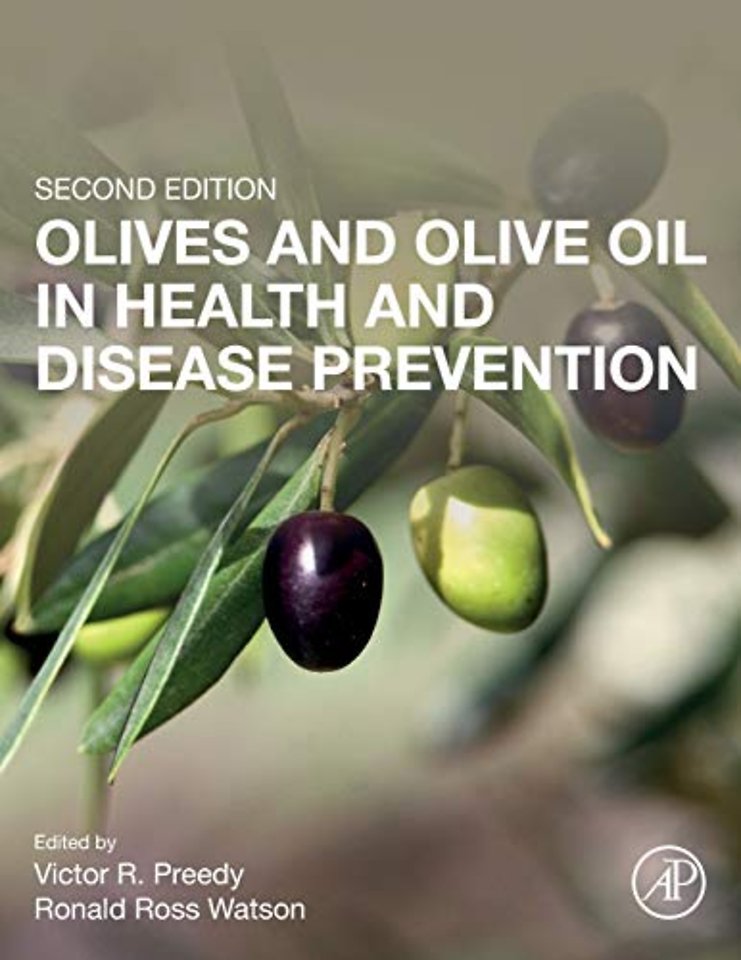<p>PART 1 General Aspects of Olives and Olive Oil<br>1.1 The plant, production, olives and olive oil and their detailed characterization<br>1. Table olives: types and trade preparations; 2. Naturally processed table olives, their preservation and uses; 3. Olive tree genetics, genomics and transcriptomics for the olive oil quality improvement; 4. The chemical composition of Italian virgin olive oils </p> <p>1.2 Components of Olives and Olive Plant Product and Uses<br>5. Bioactive ingredients in olive leaves; 6. Detection of adulterations of extra virgin olive oil by means of infrared thermography; 7. Influence of the distribution chain on the quality of extra virgin olive oils; 8. Spectroscopy to evaluate the quality control of extra virgin olive oils; 9. Chemical composition of fermented green olives; 10. Polyphenols in Olive Oil: The importance of Phenolic Compounds in the Chemical Composition of Olive Oil; 11. Polyphenol oxidase and oleuropein in olives and their changes during olive ripening</p> <p>1.3 Stability, Microbes, Contaminants and Adverse Components and Processes<br>12. Degradation of phenolic compounds found in olive products by Lactobacillus plantarum strains; 13. Microbial colonization of naturally fermented olives </p> <p>PART 2 Nutritional, Pharmacological and Metabolic Properties of Olives and Olive Oil<br>2.1 General Nutritional and Health Aspects<br>14. Overview of Olive oil in vascular dysfunction; 15. Olive in Traditional Persian Medicine: An Overview; 16. The bioavailability of olive oil phenolic compounds and their bioactive effects in humans; 17. Mediterranean Diet and role of olive oil; 18. Probiotics from Fermented Olives; 19. Olive oil-contained phenolic compounds protect cells against H2O2-induced damage and modulate redox signaling by chelating intracellular labile iron; 20. Synaptosomes as a model to study fish- and olive-oil effect as neuroprotectors; 21. Olive oil and postprandial energy metabolism: implications for weight control; 22. Effect of Olive oil on Metabolic Syndrome</p> <p>2.2 Cardiovascular<br>23. Olive and olive oil: a one stop herbal solution for the prophylaxis and management of cardiovascular disorders; 24. Extra-virgin olive oils storage: effect on constituents of biological significance</p> <p>2.3 Oxidative Stress<br>25. Antioxidants in olive oil phenolics: a focus on myoblasts; 26. Antioxidant activity in olive oils</p> <p>2.4 Cancer and Immunology<br>27. Olives and olive oil compounds active against pathogenic microorganisms; 28. Olive oil in the prevention of breast and colon carcinogenesis; 29. The effects of olive oil and other dietary fats on redox status on breast cancer; 30. Olive Pollen Allergens: an insight into clinical, diagnostic and therapeutic concepts of allergy; 31. Cancer preventive role of olives and olive oil via modulation of apoptosis and NF-κB activation; 32. Immune system and olive oil</p> <p>2.5 Other Effects, Uses and Diseases<br>33. Effect of olive oil on the skin; 34. Extra virgin olive oil, cognition and brain health; 35. The Foundation for the Use of Olive Oil in Skin Care and Botanical Cosmeceuticals; 36. Olive oil and male fertility; 37. Revealing the Molecular Mechanism of Olea Europaea L. in Treatment of Cataract; 38. Olive leaf, DNA damage and chelation therapy; 39. Olive polyphenols and chronic alcohol protection; 40. Olive oil diet and amyloidosis: focus on Alzheimer’s disease; 41. Olive biophenols benefits and challenges: A perspective; 42. Treatment and valorization of olive mill wastewater</p> <p>PART 3 Specific Components of Olive Oil and Their Effects on Tissue and Body Systems<br>3.1 Tyrosol and Hydroxytyrosol<br>43. Cancer chemopreventive activity of maslinic acid, a pentacyclic triterpene from olives and olive oil; 44. Hydroxytyrosol, olive oil and use in aging; 45. Hydroxytyrosol and hydroxytyrosyl fatty esters: occurrence and anti-inflammatory properties; 46. Influence of olive oil on pancreatic, biliary and gastric secretion. Role of gastrointestinal peptides; 47. Effects of virgin olive oil on fatty acid composition of pancreatic cells membranes: modulation of acinar cell function and signalling, and cell injury; 48. Hydroxytyrosol: features and impact on pancreatitis; 49. The Effects of extra-virgin olive oil minority compounds hydroxytyrosol and oleuropein on glioma</p> <p>3.2 Oleuropein<br>50. The usage of oleuropein on myocardium; 51. Oleuropein and skin cancer; 52. Oleuropein, olive and insulin resistance</p> <p>3.3 Oleic Acid<br>53. Oleic acid, the main component of olive oil on postprandial metabolic processes; 54. Oleic acid and olive oil polyphenols down-regulate fatty acid and cholesterol synthesis in brain and liver cells</p> <p>3.4 Oleocanthal<br>55. Olive Oil Oleocanthal and Estrogen Receptor Expression; 56. Neuroprotective Effects of Oleocanthal in Neurological Disorders; 57. S-(-)-Oleocanthal as a c-Met receptor tyrosine kinase inhibitor and its application to synergize targeted therapies and prevent breast cancer recurrence; 58. Phenolic Compounds in Olive Oil Mill Wastewater (2nd Edition)</p> <p>PART 4 Online Resources and other Recommended Material<br>Online Resources and other Recommended Material </p>

